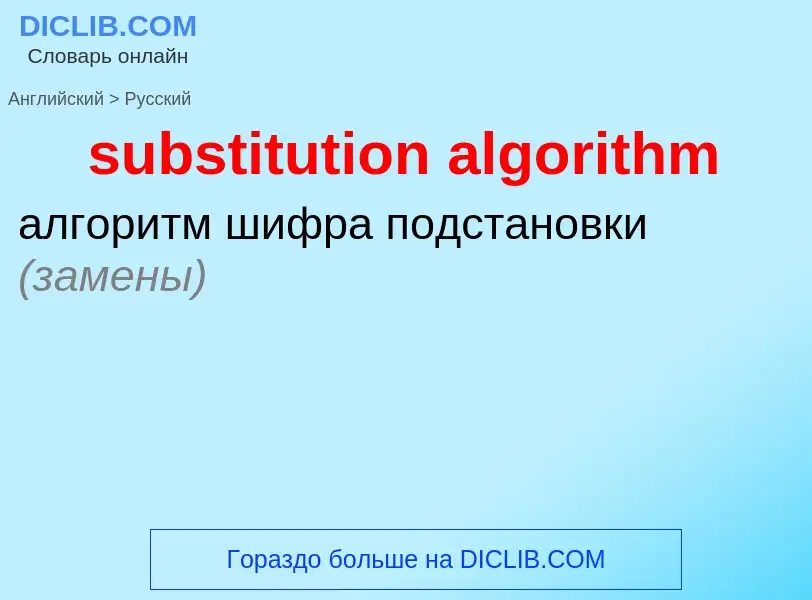Geben Sie ein Wort oder eine Phrase in einer beliebigen Sprache ein 👆
Sprache:
Übersetzung und Analyse von Wörtern durch künstliche Intelligenz ChatGPT
Auf dieser Seite erhalten Sie eine detaillierte Analyse eines Wortes oder einer Phrase mithilfe der besten heute verfügbaren Technologie der künstlichen Intelligenz:
- wie das Wort verwendet wird
- Häufigkeit der Nutzung
- es wird häufiger in mündlicher oder schriftlicher Rede verwendet
- Wortübersetzungsoptionen
- Anwendungsbeispiele (mehrere Phrasen mit Übersetzung)
- Etymologie
substitution algorithm - Übersetzung nach russisch
TERM IN MATHEMATICS
Tile-substitution; Tile substitution
substitution algorithm
алгоритм шифра подстановки (замены)
algorithm
SEQUENCE OF INSTRUCTIONS TO PERFORM A TASK
Algorithmically; Computer algorithm; Properties of algorithms; Algorithim; Algoritmi de Numero Indorum; Algoritmi de numero indorum; Algoritmi De Numero Indorum; Алгоритм; Algorithem; Software logic; Computer algorithms; Encoding Algorithm; Naive algorithm; Naïve algorithm; Algorithm design; Algorithm segment; Algorithmic problem; Algorythm; Rule set; Continuous algorithm; Algorithms; Software-based; Algorithmic method; Algorhthym; Algorthym; Algorhythms; Formalization of algorithms; Mathematical algorithm; Draft:GE8151 Problem Solving and Python Programming; Computational algorithms; Optimization algorithms; Algorithm classification; History of algorithms; Patented algorithms; Algorithmus
algorithm noun math. алгоритм algorithm validation - проверка правильности алгоритма
algorithmic method
SEQUENCE OF INSTRUCTIONS TO PERFORM A TASK
Algorithmically; Computer algorithm; Properties of algorithms; Algorithim; Algoritmi de Numero Indorum; Algoritmi de numero indorum; Algoritmi De Numero Indorum; Алгоритм; Algorithem; Software logic; Computer algorithms; Encoding Algorithm; Naive algorithm; Naïve algorithm; Algorithm design; Algorithm segment; Algorithmic problem; Algorythm; Rule set; Continuous algorithm; Algorithms; Software-based; Algorithmic method; Algorhthym; Algorthym; Algorhythms; Formalization of algorithms; Mathematical algorithm; Draft:GE8151 Problem Solving and Python Programming; Computational algorithms; Optimization algorithms; Algorithm classification; History of algorithms; Patented algorithms; Algorithmus
математика
алгоритмический метод
Wikipedia
Substitution tiling
In geometry, a tile substitution is a method for constructing highly ordered tilings. Most importantly, some tile substitutions generate aperiodic tilings, which are tilings whose prototiles do not admit any tiling with translational symmetry. The most famous of these are the Penrose tilings. Substitution tilings are special cases of finite subdivision rules, which do not require the tiles to be geometrically rigid.


![Alan Turing's statue at [[Bletchley Park]] Alan Turing's statue at [[Bletchley Park]]](https://commons.wikimedia.org/wiki/Special:FilePath/Alan Turing.jpg?width=200)




